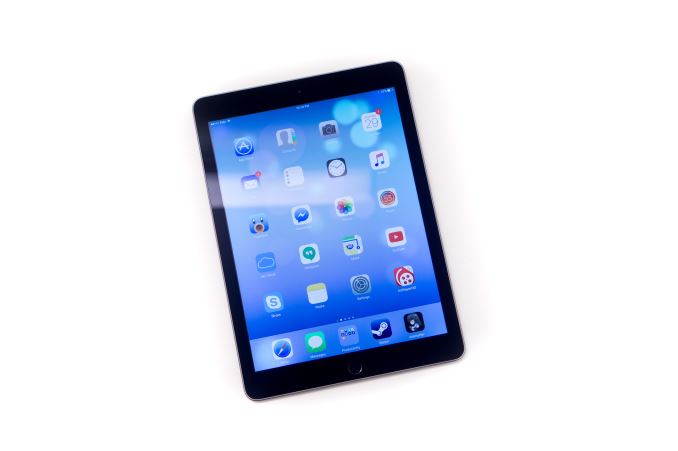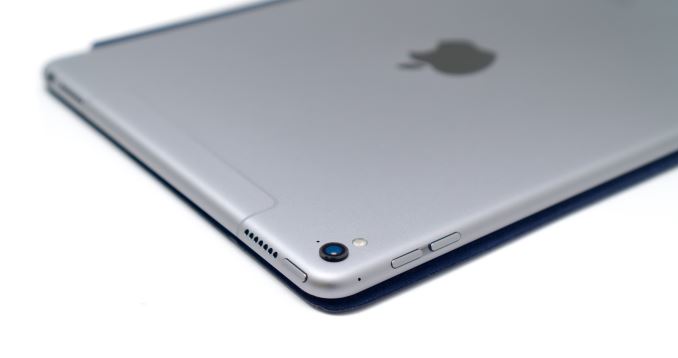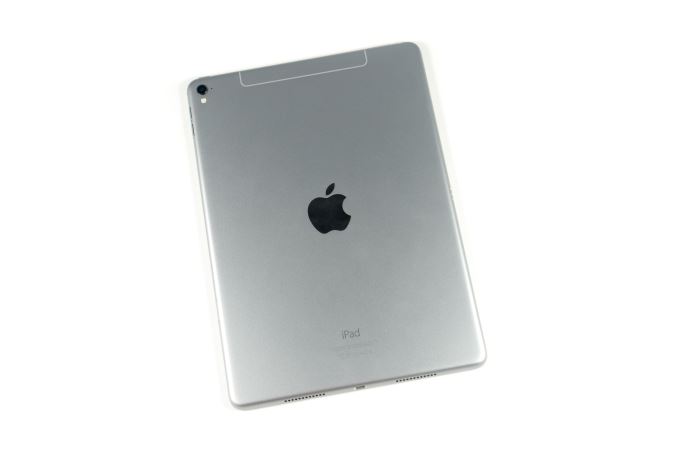The 9.7" iPad Pro Review
by Brandon Chester on June 1, 2016 9:00 AM EST
In late 2015 Apple launched a tablet that they called the iPad Pro. It had been rumored for quite some time, and it had a number of features that differentiated it from other iPads. The most notable was its 12.9" display, which has a width equal to the height of Apple's 9.7" iPads, allowing it to use two essentially full sized iPad applications at the same time in a split screen view. In addition to its massive display, the iPad Pro came with two accessories that had not existed for any prior iPad. It seemed that in Apple's eyes the Apple Pencil and the Smart Keyboard really defined what made the iPad Pro worthy of the "Pro" name.
Meanwhile, the launch of the iPad Pro came and went, and there was no news of a successor to Apple's iPad Air 2, which had just turned one year old. I thought that this move may have had to do with Apple not facing much competition in the tablet market. On the other hand, with iPad sales down it wouldn't generate much excitement to keep selling the same tablet for a second year.
After the launch of the iPad Pro the rumor mill continued to churn out new info, and there were whispers of a so called "iPad Air 3" coming in early 2016. Later, the story became that Apple was actually planning another iPad Pro to take the place of the iPad Air 2 as Apple's flagship 9.7" iPad. In the end it turned out that Apple did exactly that, and along with bringing the specs of the larger iPad Pro to a smaller size, the smaller iPad Pro comes with some surprises of its own. Below you can view the current state of the iPad line now that Apple has two devices called the iPad Pro.
| Apple iPad Family | |||
|
|
Apple iPad Air 2 | Apple iPad Pro 9.7" | Apple iPad Pro 12.9" |
| SoC | Apple A8X 3 x Apple Typhoon @ 1.5GHz |
Apple A9X 2 x Apple Twister @ ~2.2GHz |
Apple A9X 2 x Apple Twister @ ~2.2GHz |
| GPU | PowerVR 8 Cluster Series6XT | PowerVR 12 Cluster Series7XT | |
| RAM | 2GB LPDDR3 | 2GB LPDDR4 | 4GB LPDDR4 |
| NAND | 16/64/128 GB | WiFi: 32 / 128 / 256 GB | |
| WiFi + Cellular: 32 / 128 / 256 GB |
WiFi + Cellular: 128 / 256 GB |
||
| Display | 9.7" 2048x1536 IPS LCD | 12.9" 2732x2048 IPS LCD | |
| Gamut | sRGB | DCI-P3 | sRGB |
| Size and Mass | 240 x 169.5 x 6.1mm 437g WiFi, 444g LTE |
305.7 x 220.6 x 6.9 mm 713g WiFi, 723g LTE |
|
| Camera | 8MP Rear-facing f/2.4, 1.1 micron |
12MP Rear-facing f/2.2, 1.22 micron |
8MP Rear-facing f/2.4, 1.1 micron |
| 1.2MP Front-facing f/2.2 | 5MP Front-facing f/2.2 | 1.2MP Front-facing f/2.2 | |
| Battery | 27.3 Wh | 27.5 Wh | 38.5 Wh |
| Launch OS | iOS 8 | iOS 9 | |
| Cellular | Category 4 LTE + GPS/GNSS in Cellular SKU | ||
| Other Connectivity | 2x2 802.11a/b/g/n/ac + BT 4.2, Apple Lightning, Smart Connector on iPad Pro | ||
| SIM | Optional NanoSIM | ||
| Current Price |
16GB: $399 |
32 GB: $599 128 GB: $749 256 GB: $899 |
32 GB: $799 128 GB: $949 256 GB: $1079 (LTE) |
The 9.7” iPad Pro has the same core industrial design that Apple’s iPads have used since the launch of the iPad Air. The back is almost entirely flat, curving up quickly near the edges and meeting the cover glass with a shiny chamfered edge. Like the 12.9” model, the 9.7” iPad Pro changes things up by moving to a four-speaker audio setup, which requires holes drilled on both the top and bottom of the chassis. Interestingly, the 9.7” iPad Pro uses asymmetrical speaker grilles, with the bottom two being larger than those of the 12.9” model, and the top being smaller. This is likely due to the more constrained space inside the chassis. As for the speakers themselves, the audio quality did seem to be a step down from the larger iPad Pro, but it’s still miles ahead of anything else that I’ve seen on a tablet of this size and a significant improvement from the iPad Air 2.
The 9.7” iPad also comes with some changes of its own. The camera now has a hump, which will undoubtedly upset those who focus heavily on the uniformity of the design. There was no good way to improve upon the iPad Air 2’s camera within a 6.1mm chassis without putting a hump, and as we’ll see later, the camera in this iPad Pro is a huge improvement over Apple’s other iPads. While the hump is there, with such a large chassis the angle it makes with a flat surface is so small that the tablet doesn’t rock back and forth when using it on a table, which is extremely important to ensure the usability of the Apple Pencil.
Apple has also changed up the antenna design. Going back to the first iPads, the cellular models have sported a plastic RF window at the top of the chassis to allow for RF propagation. With the 9.7” iPad Pro, Apple adopts a similar antenna design to that of the iPhone 6 and 6s, where the top now has a metal segment for the antenna with insulating plastic lines surrounding it.
I think this is a significant upgrade to the design of the cellular model for a couple of reasons. Aesthetically it simply looks better, as the plastic inserts weren’t color matched and so they stood out from the rest of the aluminum back cover. They also weren’t always aligned perfectly, and so at the edge between the plastic and the aluminum you could feel a noticeable seam due to the plastic being either at a higher or lower level than the chassis. The new antenna design eliminates both of these issues, and brings the 9.7” iPad Pro as close as it can get to an unbroken aluminum unibody when also having to support cellular networking.
Beyond the changes with the camera, speakers, and antenna on the cellular model, the 9.7” iPad Pro has the same design as the iPad Air 2. They share the same mass and dimensions, and as I mentioned before the core ID is the same. Whether or not Apple could improve upon the design further is up for debate, but they don’t really have any true competition in this space and so they’ve been able to maintain their design lead by making iterative improvements on the original iPad Air design. That design still works very well, and so I don’t see much reason to change things up significantly just for the sake of saying you have a new design.












144 Comments
View All Comments
zeeBomb - Wednesday, June 1, 2016 - link
About time! As a Canadian: to buy or not to buy... That is the question.sachouba - Wednesday, June 1, 2016 - link
It's funny how the iPad Pro 9.7 is compared with the Galaxy S6, the middle range Nexus 5X or the 6 months old Huawei Mate 8 instead of the Galaxy S7, Huawei P9, Xiaomi Mi5 or other 2016 flagships when it comes to performance, display accuracy, recharging time, storage speed, etc.Even with a multicore CPU performance that is not as good as the best CPUs on smartphones right now (the Galaxy S7, for instance), a mediocre contrast (what is the point of having accurate colors if blacks cannot even be rendered properly ?), a price that is way too high, and a battery life that is far from impressive, the iPad Pro is praised in your review...
When it comes to the conclusion, it looks like Apple has invented the "True Tone Display", although it is only a copy of the 2-year-old and not-much-marketed Adapt Display from Samsung – which works great and adapts the white point according to the surrounding environment. You have fallen in Apple's trap of making people believe they invented everything that is known and unknown to Man thanks to aggressive marketing, which is disappointing, to say the least...
Brandon Chester - Wednesday, June 1, 2016 - link
You must have missed the LG G5 in the charts, which is a Snapdragon 820 device. I can't compare to devices that haven't been fully reviewed.Also, you may want to re-read the article to find out why True Tone is not the same as Adapt Display, and to clarify some other things that it seems you missed.
jlabelle2 - Wednesday, June 1, 2016 - link
Quite condescending statement when what you wrote was : "As you move to different environments the color temperature of the display shifts to match how your eye adjusts its perception of white depending on the temperature and brightness of the light around you."Which is exactly what Sachouba describe about Samsung Adapt Display...
jlabelle2 - Wednesday, June 1, 2016 - link
Since departure of Anand, Apple product reviews look like PR marketing speech, although the tests and content itself of the review do not match the speech :- "It’s not hard to conclude that the display on the 9.7” iPad Pro is the best display on any tablet" : except that the Surface (Pro 4) has be shown as having a better display (proven also by Displamate) and the Surface 3 is also shown to have a better display or at least as good with the huge avantage for someone really after color accuracy that they can be calibrated.
- "However, the significant hardware upgrades that Apple has made with this new iPad Pro are enough to make up the difference. the 9.7” iPad Pro is only $50 more than the 128GB iPad Air 2 used to cost" : an argument that makes no sense. EVERYTIME the year passes and a new phone or tablet is released, we used to have more power or a better camera or better performance ... for the SAME price. Otherwise, what is the point of the new model ? Except that here, it is more expensive than the previous model. And it is between 100 to 200$ more expensive than the iPad Air 2. And if you want really to take advantage of the real benefit of the Pro (the keyboard and / or the pencil), you need to spend 100 to 270$ !?! Just insane.
- "As far as performance goes, A9X is still the fastest chip that you’ll find in an ARM tablet" : why restricting tablet to ARM processor ? What does it change for the end user if a tablet is running an ARM chip or a x86 chip ? Especially when even a fanless core M smokes the A9X ? And this is good to make the apology of the power of the "small" iPad Pro but what application is taking advantage of this power versus the iPad Air 2 ? Especially with the 2Go of RAM only ?
- "In the end, the 9.7” iPad Pro is clearly the best standard-sized tablet on the market." : and here it is. How can it be objectively labelled like this ? It seems an excellent tablet but making this universal statement when it is the most expensive, it has not the best display (when it really counts for some), it does not have the best keyboard implementation, it is limited by its RAM, and the biggest asset is also its biggest issue of course as it suffers from limited external peripheric support and of some powerful application / program that people who want a powerful tablet with a good display usually are after (photo / video editing, graphist...). So the hardware strengths are constrained by the software capabilities.
Strange wordings and conclusions regarding a overall very nice tablet but with its share of drawback for its intended audience.
Lochheart - Wednesday, June 1, 2016 - link
Do you know any 10" Tablet with Core M ?digiguy - Wednesday, June 1, 2016 - link
Have a look: http://www.onda-tablet.com/onda-v919-3g-core-m-tab...kmmatney - Thursday, June 2, 2016 - link
I would not recommend an Onda tablet - I bought one myself and it was a bit of a nightmare. There is very little support. A windows update reversed my touchscreen and was a pain to fix. The glass on the screen cracked with very minimal pressure, and finally one-third of the touchscreen simply stopped responding to touch. This was all within 4 months. I finally just sold mine on ebay, with a cracked screen, and telling the buyer that it could only be used with a mouse and keyboard. At least mine was a lot cheaper than the one you linked to, but cannot recommend an Onda tablet...digiguy - Thursday, June 2, 2016 - link
I am not recommending either, just showing that it's feasibleLochheart - Friday, June 3, 2016 - link
Feasible... but does it works ? Throttling, Heat, 1h battery life...And... Windows !